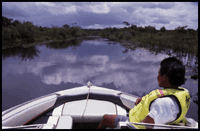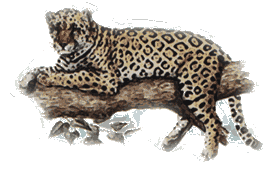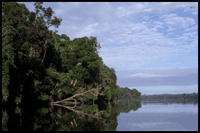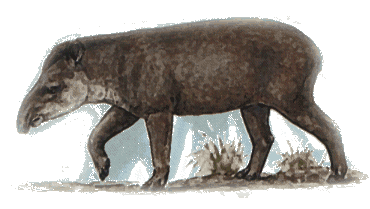Discuss your ideas on the Iwokrama Talkboard
Visitors Guide General Rules
General Rules
|
 The International Centre for Rainforest Conservation and Development |
|
Aims
The stated aim of the project is to "promote the conservation and the sustainable and equitable use of tropical rainforests in a manner that will lead to lasting ecological, economic and social benefits to the people of Guyana and to the world in general, by undertaking research, training and the development and dissemination of technologies." It will concentrate on how to develop the rainforests in a sustainable way whilst conserving the biodiversity of this unique biome (Biome = large-scale ecosystem). Location and description The site of the Iwokrama Project covers 360,000 hectares (almost a million acres) in the centre of Guyana 300kms south of Georgetown (see Guyana map). Although there is a road - of sorts - from Georgetown to Lethem, the only real way into the rainforest is by river or on foot.
The area has been virtually untouched, even by the indigenous Amerindians. Although there are a number of villages near to Iwokrama, only one is actually inside the area of the project - the settlement of 'Kurupukari (Fairview)'. How the project began At the meeting of the Commonwealth Heads of Government in Malaysia in 1989, Desmond Hoyte, then Guyana's President, put forward the idea of setting aside a rainforest site in Guyana as a 'living laboratory' not just to help Guyana manage its rainforests sustainably, but as an example to the rest of the world. It was to be managed by both Guyana and a group of Commonwealth experts. In 1993 the United Nations Development Programme (UNDP) granted 3 million US$ to help set up the project. By 1994 the first field station was built in Iwokrama and training and research began. Management
The Iwokrama area is managed as two distinct halves - one half as a wilderness preserve and the other half for sustainable use and development. There is a Field Station near the Amerindian village of Kurupukari with limited accommodation for visitors and researchers plus a range of qualified permanent staff. The station has its own generator and clinic and is building an automatic weather station. The data recorded and collected here is essential to the success and development of the Iwokarama Project. Links and partnerships Developing good links and partnerships with local people, the rest of Guyana, international groups and potential donors is very important.
Biodiversity As the table shows, Iwokrama contains a vast range of plants and animals (flora and fauna). In particular it has quite big populations of the larger animals such as jaguar, black caiman, harpy eagles, river otters, giant turtles and tapirs. The project is looking to preserve this biodiversity of the rainforest whilst sustainably developing its economic potential.
Table: Flora & Fauna of the Iwokrama Project 1999 Guyana figures in brackets:
Educating a wider population about wildlife and biodiversity and the importance of conserving it has been discussed by the NRDDB. It has been suggested that village councils themselves take an active role in this education process, helped by Iwokrama rangers and the setting up of workshops. Why not discuss your ideas on the Iwokrama Talkboard. |

 The Essequibo river forms much of Iwokrama's eastern boundary, but several other rivers and tributaries flow through it. The area contains a variety of landscapes with plains, rolling hills, rivers and river valleys plus the steep Pakatau Hills and Iwokrama Mountains - the latter reaching up to 1000m high in the centre of the area. Most of the land is covered with dense, pristine (untouched) tropical rainforest, although the actual trees and plants found vary from place to place. Constant high temperatures and yearly rainfall totals of between 2000 - 2500 mms account for this richness.
The Essequibo river forms much of Iwokrama's eastern boundary, but several other rivers and tributaries flow through it. The area contains a variety of landscapes with plains, rolling hills, rivers and river valleys plus the steep Pakatau Hills and Iwokrama Mountains - the latter reaching up to 1000m high in the centre of the area. Most of the land is covered with dense, pristine (untouched) tropical rainforest, although the actual trees and plants found vary from place to place. Constant high temperatures and yearly rainfall totals of between 2000 - 2500 mms account for this richness.
 Management of the Iwokrama project is concentrating on five core areas:
Management of the Iwokrama project is concentrating on five core areas:
 In the process of collecting this data, a number of local people have been trained in surveying techniques. The information collected is being used to create field guides to the area. In future years an extensive photographic programme will take place to help illustrate these field guides.
In the process of collecting this data, a number of local people have been trained in surveying techniques. The information collected is being used to create field guides to the area. In future years an extensive photographic programme will take place to help illustrate these field guides.